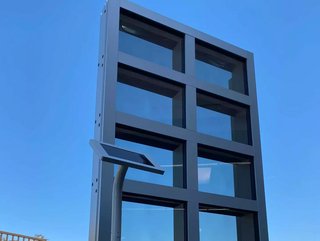Next Energy Technologies delivers PV window to Paris partner

Next Energy Technologies, makers of a proprietary transparent PV coating that transforms commercial windows into energy producing solar panels, has delivered its PV Prototype Window Wall to Bouygues Construction in Paris.
Bouygues is a leading construction firm that specialises in complex commercial projects and the deal comes weeks after Next announced its $13.4 Million Series C round of funding (click here).
The PV Prototype Window Wall was delivered by NEXT in collaboration with its partners, Walters & Wolf, a leading commercial curtainwall manufacturer and glazing subcontractor headquartered in Fremont, California, and commercial glass fabricator, Glassfab Tempering Services/Solarfab in Tracy, California.
“NEXT’s technology is both unique and promising. We’re proud to support their collaboration with Bouygues Construction and will continue to work side by side with them in bringing their product to market,” said Nick Kocelj, President of Walters & Wolf.
“We support NEXT Energy in their focused effort in providing a unique and innovative product to the architectural market. When presented the opportunity to participate in this project, we were eager to assist in any way possible”, said Brian Frea, President of Glassfab Tempering Services/ Solarfab.
NEXT’s proprietary transparent PV coating transforms commercial windows into energy-producing solar panels by converting unwanted infrared and UV light into electricity. This fully integrated system can help enable buildings to power themselves with their windows which retain their traditional transparency and performance.
The prototype installation consists of 10 transparent PV windows that supply electricity to a battery that powers an interactive display as well as auxiliary charging outlets, for phones, tablets and other electronics.
The purpose of this prototype demonstration is to showcase the power generation functionality, the exceptional transparency and aesthetics, and the seamless integration of NEXT windows into a standard glazing system designed by Walters & Wolf to carry the electronics, wiring and hardware that comprise the balance-of-system. This direct integration into traditional commercial window and framing systems effectively extracts costs typically associated with packaging and installation of solar.
Installed in a typical commercial high-rise office building, the first generation of Next windows would offset as much as 10-20% of its power needs, and over a 30-year timeframe, such a building would produce about 20 million kWh of clean power, saving an average of $170,000 annually on utility bills and reducing 14,500 metric tons of carbon dioxide from the atmosphere, the equivalent of powering 1,700 homes for an entire year. In the coming years, Next windows will be commercially available for window sizes up to 5 ft. x 10 ft (1.5 x 3 meters).
Supply Chain solution to the climate crisis
Next’s PV coatings are applied to commercial windows during the window fabrication process, integrating with existing manufacturers without disrupting established workflows and supply chains. This capital-efficient business model reduces risks to customers, removes barriers to adoption, and accelerates speed to market, all while adding a high-value product to the market. This direct integration into traditional commercial window and framing systems effectively extracts costs typically associated with packaging and installation of solar.
"We are excited to be one of the first global construction companies pioneering NEXT's revolutionary transparent solar panel windows. This innovation will allow Bouygues Construction to offer its clients a simple, sustainable, and profitable solution for buildings that are autonomous in the management of their energy," said Christian De Nacquard, R&D and Innovation Director, Bouygues Bâtiment International.
The EU aims to be climate-neutral by 2050, requiring a fundamental transformation of the construction and building sectors, and 100% of new commercial buildings in California will be designed to zero net energy (ZNE) standards by 2030. Globally, buildings generate an estimated 40% of annual GHG emissions.
“Addressing the climate crisis at the corporate level requires creative and cost-effective solutions. Commercial buildings are an excellent example of something that can be re-imagined and improved to reduce carbon emissions and overall impact,” said Daniel Emmett,
CEO of NEXT.
“At a more personal level, we’re seeing employees returning to office buildings after more than a year of lockdown vocally prioritise healthy and sustainable work environments as a requirement of in-person work."
In a recent survey, 74% of employees said they would consider changing jobs if their company did not meet their requirements for a healthy and sustainable office environment, added Emmett.






